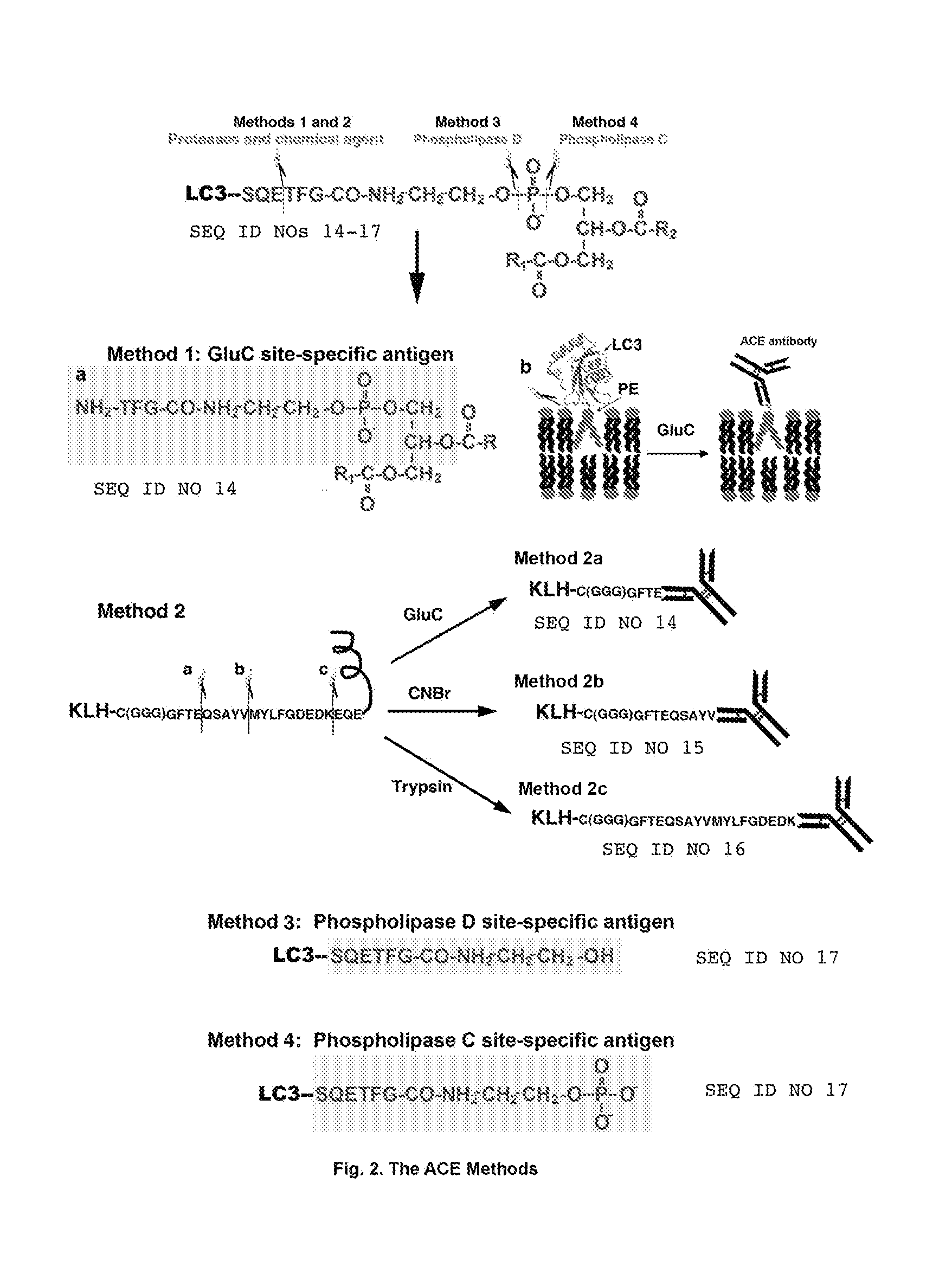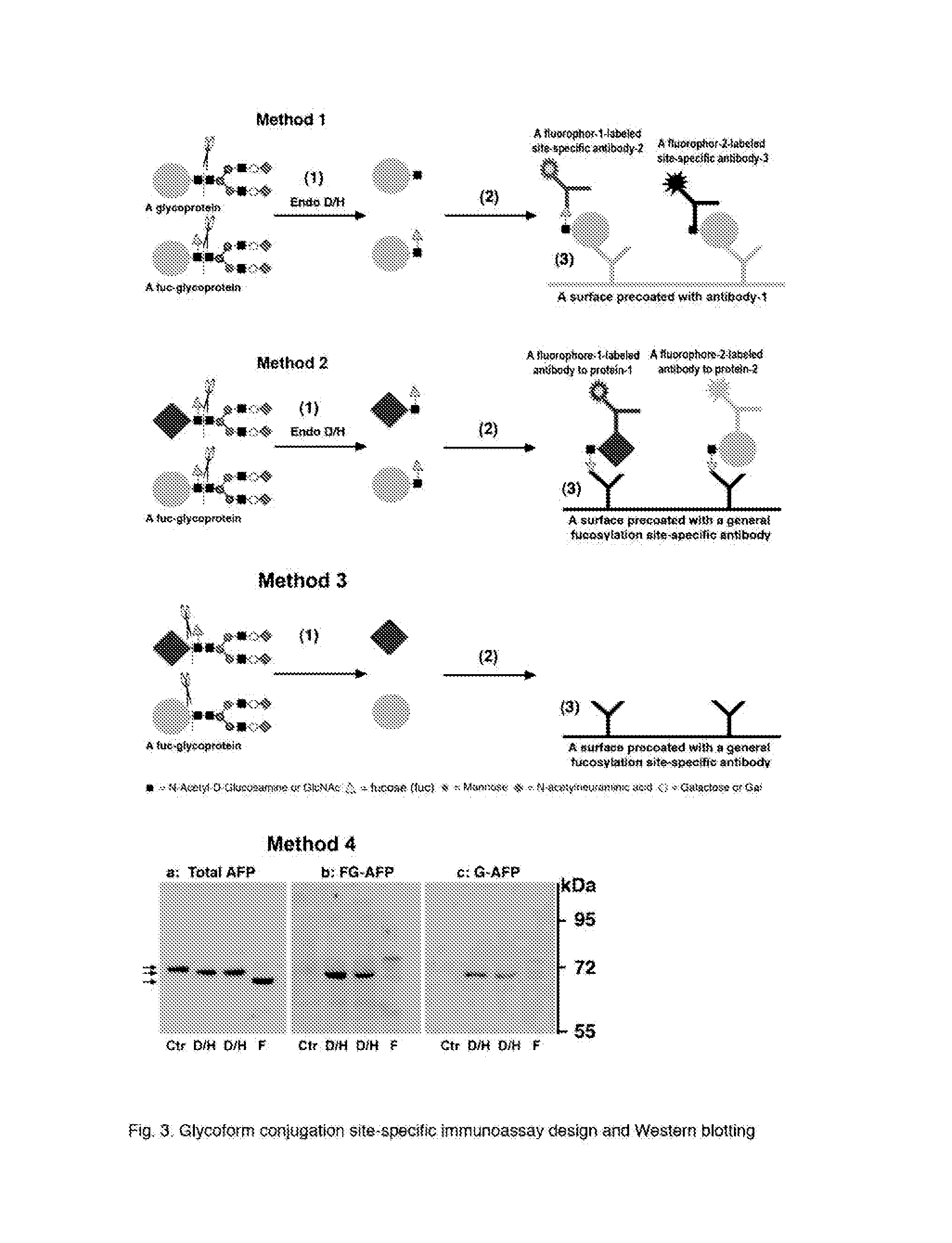Methods of Detecting Conjugation Site-Specific and Hidden Epitope/Antigen
a conjugation site and antigen technology, applied in the field of methods, antibodies, reagents, immunoassays and kits for designing and detecting hidden antigens, can solve the problems of many antigens, many antigens, and most antibodies that don't work as users, so as to reduce non-specific binding
- Summary
- Abstract
- Description
- Claims
- Application Information
AI Technical Summary
Benefits of technology
Problems solved by technology
Method used
Image
Examples
example 1
A SUMO-To-Protein Conjugation Site-Specific ACE Structure Design
[0140]A SUMO can conjugate to many proteins including itself by an isopeptide bond. As demonstrated in FIG. 1A, a SUMO-to-SUMO conjugation site is between one SUMO C-terminal end glycine (G) and another SUMO internal lysine K11. Based on the ACE methods, a GluC-cleaved SUMO-to-SUMO conjugation site-specific hapten can be designed as GVK(GGTQQQFVDITDC)TE, wherein “C” is added to the hapten and conjugated to an immunogenic carrier, including, but not limited to, KLH or BSA to make the hapten a complete antigen. The conjugation site-specific antibody to GVK(GGTQQQFVDITDC)TE can be made with the complete antigen and purified with the hapten-conjugated resin or other supportive materials [e.g., GVK(GGTQQQFVDITDC-resin) TE]. The non-conjugation site antibodies can be removed by non-conjugated linear peptide-linked resin(s), e.g., (resin-GVKTE) and (GGTQQQFVDITDC-resin). After treatment with a protease or agent such as the des...
example 5
The fatty Acid-To-Protein Conjugation Site-Specific ACE Design
[0162]Similar to lipidated proteins described above in Example 2, a wide variety of cellular or viral proteins are covalently conjugated with a 14-carbon fatty acid myristate(s) and / or a 16-carbon fatty acid palmitate(s), as well as other fatty acids or lipid-related molecules. These types of protein lipidation are for associating the proteins to cell membranes from the cytoplasmic sides. Examples of making fatty acid-to-protein conjugation site-specific antibodies and their use thereof are shown in FIG. 6. Caveolin-1 is palmitoylated at three cysteine residues C133, C143 and C156 (Homo sapiens). A C133 palmitoylation site-specific ACE contains a base sequence set forth by SEQ ID NO: 3 and can be designed as CGGGAVVPC133(palmitate)IK, wherein the N-terminal C is added for conjugation to an immunogenic carrier; wherein “GGG” is a spacer; and wherein palmitate is linked covalently to the C133. The conjugation site-specific ...
example 6
GPI-to-Protein Conjugation Site-Specific ACE Design
[0165]GPI is post-translationally conjugated to a group of structurally and functionally diversified proteins via an ethanolamine linker. This group of proteins is anchored in the outer leaflet of the cell membrane. FIG. 7 shows two examples of the ACE antigen design for making conjugation site-specific antibodies to GPI-anchored proteins and their use thereof. One is the prion protein (PrP) (Homo sapiens) that is conjugated by a GPI-anchor at the cysteine residue C230. A conjugation site-specific ACE hapten contains a base sequence set forth by SEQ ID NO: 8 and can be designed as GC-phosphoethanolamine-SGGGC, wherein “SGGG” is added as a spacer and a linker that, via the serine hydroxyl side chain, links to phosphoethanolamine; wherein C is added for conjugation to KLH or BSA for making the hapten a complete antigen. The conjugation site-specific antibody to GC-phosphoethanolamine can be made with the complete antigen and purified ...
PUM
 Login to View More
Login to View More Abstract
Description
Claims
Application Information
 Login to View More
Login to View More - R&D
- Intellectual Property
- Life Sciences
- Materials
- Tech Scout
- Unparalleled Data Quality
- Higher Quality Content
- 60% Fewer Hallucinations
Browse by: Latest US Patents, China's latest patents, Technical Efficacy Thesaurus, Application Domain, Technology Topic, Popular Technical Reports.
© 2025 PatSnap. All rights reserved.Legal|Privacy policy|Modern Slavery Act Transparency Statement|Sitemap|About US| Contact US: help@patsnap.com



